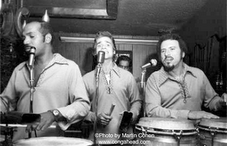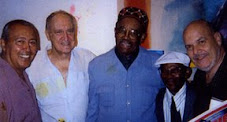
For many years,
dance hall posters could be seen on corner lampposts around the city. They added a bright note to an otherwise grey concrete world. Some communities were awash in colorful invitations to the dances. Many remained visible long after the event they served, but with the beginning of the Quality of Life policy they were outlawed, along with stale election campaign slogans, eyesores and graffiti.
Post No Bills was enforced. Climbing a lamppost to get at one of these disappearing treasures became increasingly risky. The sponsors became aware of a thief and began to secure their posters ever higher and more securely with tape, staples, glue and nails. Soon these cheerful placards became a dying artifact, replaced by handbills distributed at dancehall entrances like throwaway circulars, or leaflets arriving by third-class mail.
During the 1890s, announcements of events took the form of playbills, especially along the 14th Street’s theatrical district. Unlike Europe where paper was expensive, “towns in America were covered with posters lacking artistic value,” wrote Jules Cheret in The Poster by Alain Weill. Nineteenth century posters advertising many various products such as bicycles or soap were “puns in design,” similar to the 1980s Roseland poster, “Women’s Lib Dance.”
The scope of the exhibit portrays the growth and expansion of Latin music from 1970 to the present. A portion of it displays classic Anglo festivities such as Thanksgiving Day, Memorial Day, Sadie Hawkins Day and the Fourth of July. When the first “Latino Music Festival” opened at Madison Square Garden in the early ’70s, admission was $7 and it featured ten bands. Today, general admission is $45 and may show one band. If ten top celebrities are billed, they will appear on stage only to receive applause but not to perform. Like the baseball fan, loyal to his sport, the Latino is devoted to his joyous music. “Rumba for breakfast, rumba for lunch, rumba for dinner,” as the saying goes.
Historically important is the Corso poster. This dancehall marked the “crossover” from East Harlem’s barrio to the German-American neighborhood of Yorkville. It played top bands from “9pm to 6am.” Latino valentinos came down Lexington Avenue and kept going. It awakened communities to the pleasure of “going dancing” on Saturday night. Beyond the borders of the barrio, Latinos felt free in this Home of Latin Music. Before this, La Conga, China Doll, the Martinique and the Embassy were nightclubs and not dancehalls. They avoided using street corner posters. The venerable Roseland and the theatrical Palladium lacked the intimacy of the darkened ambiance of the Corso, where black and white blended and bonded. The Corso can be said to have begun the disco scene in New York.
In third world countries, where there are no movie houses, people attend dances in a local schoolhouse. Open air makeshift dirt floors serve quite well. In the ’30s and ’40s, along Havana’s Malecon, street floor apartments served as dance “clubs.” An improvised bar on the kitchen table sold shots of rum for cinco kilos (five cents). Usually, the family were the musicians together with neighbors who helped round out the modest conjunto. These spots catered to the average Habenero or to the after-work passerby who would step in for a precisos bolero, to relax or to pursue a romantic interlude.
Latin bands produce beautiful music with powerful basic discipline and synchronous relaxed movement. While sustaining the values of traditional holidays, these dancehalls celebrate life in spite of linguistic separation. Abre paso! (Give way!) is a popular dance floor expression along with Dale aire! (Give me air!…Give me room!…to show my stuff). These words may well symbolize the Latino’s cry for fuller recognition of a melodious culture. Allow Babalu to become Negro de Sociedad.
Thousands of people come to Times Square seeking “something.” Unfortunately, they ignore the colorful posters on the corner lampposts with their odd names: Buyú, Mongo, Corso, Caborojeño.
Although there is much electricity in the air, like the rush you feel as you begin to dance your way onto a crowded dance floor, the crowds should accept the invitations extended by the posters. The Audubon, the Park Plaza, the Broadway Casino…these salones de baile, where musicians give you the very air in their lungs, the nimbleness in their fingers, their sweating talents. They will send you dancing off into space, they will satisfy your wish to fly. Seek no more.
That famous Broadway ballroom, the Palladium, was a barn-like showplace that could hold a dozen Park Plazas. The modest Park Plaza served to compact the dancers. It concentrated the impact of the music that shook the building. Like the famous Cuban sala, the “salon” is where one goes to dance and not to see a show with dancing to follow. The salon is not the elite “room” or the unwholesome disco. It is where in an atmosphere of overlapping perfumes one might hear lyrics like, “Nacieron las flores cuando naciste tu.” Where one can find a more romantic stimulation outside of “la blanda cama” (the soft bed) or the frenzy that makes sensuality a graceful art form?
“You will carry this music around the world,” a Babalao once told me. Was it a command or a prophecy? So I solicit you, who carry this music in your hearts: Go forth, propagate this gift…invite the world to dance!
¡A bailar!
 For many years, dance hall posters could be seen on corner lampposts around the city. They added a bright note to an otherwise grey concrete world. Some communities were awash in colorful invitations to the dances. Many remained visible long after the event they served, but with the beginning of the Quality of Life policy they were outlawed, along with stale election campaign slogans, eyesores and graffiti. Post No Bills was enforced. Climbing a lamppost to get at one of these disappearing treasures became increasingly risky. The sponsors became aware of a thief and began to secure their posters ever higher and more securely with tape, staples, glue and nails. Soon these cheerful placards became a dying artifact, replaced by handbills distributed at dancehall entrances like throwaway circulars, or leaflets arriving by third-class mail.
For many years, dance hall posters could be seen on corner lampposts around the city. They added a bright note to an otherwise grey concrete world. Some communities were awash in colorful invitations to the dances. Many remained visible long after the event they served, but with the beginning of the Quality of Life policy they were outlawed, along with stale election campaign slogans, eyesores and graffiti. Post No Bills was enforced. Climbing a lamppost to get at one of these disappearing treasures became increasingly risky. The sponsors became aware of a thief and began to secure their posters ever higher and more securely with tape, staples, glue and nails. Soon these cheerful placards became a dying artifact, replaced by handbills distributed at dancehall entrances like throwaway circulars, or leaflets arriving by third-class mail. 

No comments:
Post a Comment